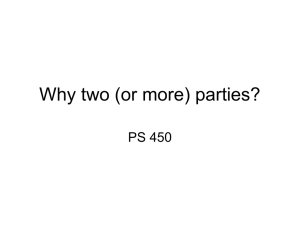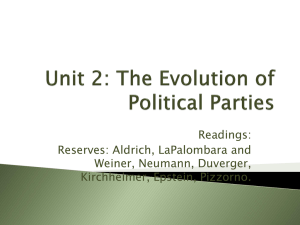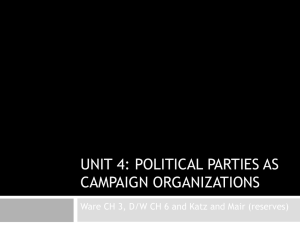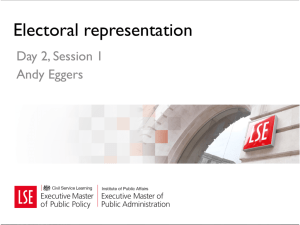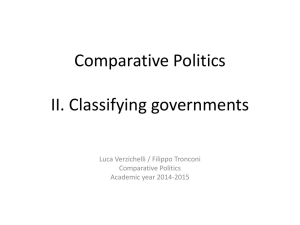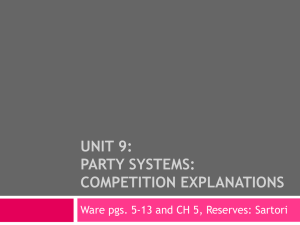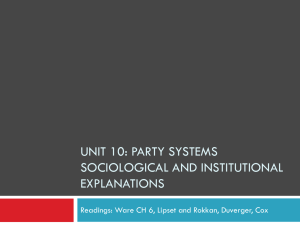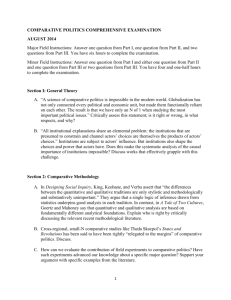Did Duverger go against the trend…
advertisement
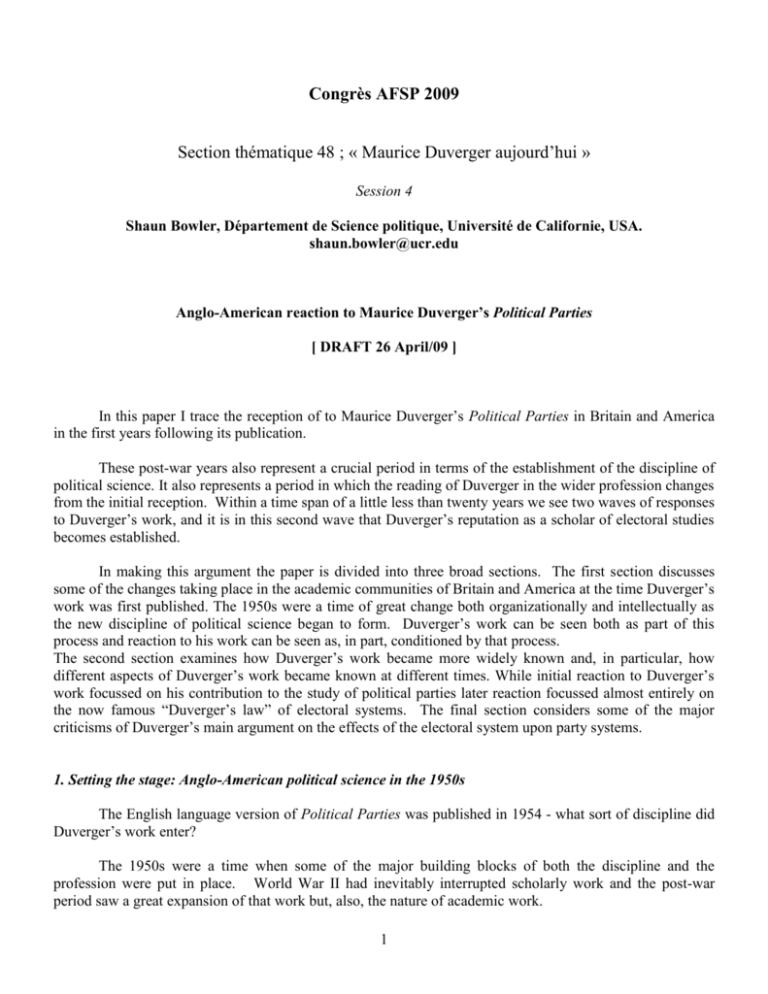
Congrès AFSP 2009 Section thématique 48 ; « Maurice Duverger aujourd’hui » Session 4 Shaun Bowler, Département de Science politique, Université de Californie, USA. shaun.bowler@ucr.edu Anglo-American reaction to Maurice Duverger’s Political Parties [ DRAFT 26 April/09 ] In this paper I trace the reception of to Maurice Duverger’s Political Parties in Britain and America in the first years following its publication. These post-war years also represent a crucial period in terms of the establishment of the discipline of political science. It also represents a period in which the reading of Duverger in the wider profession changes from the initial reception. Within a time span of a little less than twenty years we see two waves of responses to Duverger’s work, and it is in this second wave that Duverger’s reputation as a scholar of electoral studies becomes established. In making this argument the paper is divided into three broad sections. The first section discusses some of the changes taking place in the academic communities of Britain and America at the time Duverger’s work was first published. The 1950s were a time of great change both organizationally and intellectually as the new discipline of political science began to form. Duverger’s work can be seen both as part of this process and reaction to his work can be seen as, in part, conditioned by that process. The second section examines how Duverger’s work became more widely known and, in particular, how different aspects of Duverger’s work became known at different times. While initial reaction to Duverger’s work focussed on his contribution to the study of political parties later reaction focussed almost entirely on the now famous “Duverger’s law” of electoral systems. The final section considers some of the major criticisms of Duverger’s main argument on the effects of the electoral system upon party systems. 1. Setting the stage: Anglo-American political science in the 1950s The English language version of Political Parties was published in 1954 - what sort of discipline did Duverger’s work enter? The 1950s were a time when some of the major building blocks of both the discipline and the profession were put in place. World War II had inevitably interrupted scholarly work and the post-war period saw a great expansion of that work but, also, the nature of academic work. 1 As Table 1 shows, the period from the late 1940s through the 1950s saw the founding of important developments with the founding of new journals and new professional associations. Some of the initial developments had been seen in the US early in the century with the establishment of the APSA and APSR. But what we see, even in the US, is the spreading of these elements of professionalism to the regions with the setting up of journals and associations outside the North East of the country. Other nations, too, begin to set up both journals and professonal associations in this period. No fewer than seven new political science journals, essentially doubling the number that had existed prior to that period. This period also saw an even bigger expansion organizationally with the founding of nine major associations that still exist today. Table 1 about here Duverger’s work was therefore published at a time when the discipline of political science was rapidly expanding, the nature of work was changing to a more article driven format and the spreading of professional associations was making more of a profession than a vocation. But this period was not just a matter of organizational and sociological changes in the nature of the enterprise of the study of politics, it also involved changes in intellectual outlook, too. There were signs that the profession was seeking to become both more comparative in focus and, also, more scientific. In 1948 UNESCO supported and sponsored a conference on Methods in Political Science which resulted in the 1950 volume Contemporary Political Science (UNESCO, 1950). The volume discusses approaches and problems to the study of politics with the express goal of encouraging a more systematic and, possibly, more comparative effort. Among the contributors were leading figures in Anglo-American political science including Charles Merriam, GDH Cole, Harold Lasswell and Merle Fainsod and from France Raymond Aron, Francois Goguel and Maurice Duverger. This general effort at encouraging and systematizing the study of comparative politics were followed up in a number of subsequent meetings in the US and in a 1954 conference in Florence organized by IPSA that resulted in Gunnar Hecksher’s Study of Comparative Government and Politics (1957; see also Neumann, 1959). In many ways these efforts marked a self-conscious attempt for the new discipline – especially in Europe - to distinguish itself from its’ previous intellectual antecedents in public law, history, philosophy and, in the Anglo-American tradition at least, political economy. Graziano (1987), in his study of the development of Italian political science, termed these earlier disciplinary intellectual antecedents the ‘political studies’ tradition for the new discipline of political science and here I adopt that same label: the 1950s, then, represented a period of change from political studies to political science when both strands of thought were present in the academy. Despite the enthusiasm and ambition evident in the UNESCO volume and the Florence conference it is hard to gauge how influential these efforts actually were in terms of the wider academy. There is some reason for thinking that these ambitions had relatively limited impact. In 1954, for example, in the middle of this expansion of professionalism, with new organizations and new ambitions, a review of the articles published in the first issue that year of the American Political Science Review and the (new) Political Studies shows a pronounced preference for the ‘political studies’ approach (see Table 2). Table 2 about here The journal issues reported in Table 2 seem typical of the year. They are also typical of some persistent hallmarks of the professions in the two countries. British political science, for example, still 2 exhibits a stronger presence of political theory in the profession than the US profession while, for the latter, there exists a stronger concern for the law and courts1. But, by and large, differences to one side the emphasis within these journals is on single country studies2. In writing of French political science for the UNESCO report Raymond Aron noted that “French scholars were more inclined to investigate the peculiarities of their own politics than to define the place of French politics in the historic evolution of western societies. However valuable this kind of political sociology may have been, it opened no windows on the outer world or the future” ( UNESCO: 1950: 56). It is a harsh – probably over-harsh - assessment, but to the extent that it holds true one that could also apply it to scholarship in the UK and US as well. The scholarly concerns of Anglo-American writers were – by and large – fixed on Anglo-American experiences. The goals of the international conferences and reports, then, seemed to have been more aspirational than actual; and the conduct of political science in the US and Britain during the 1950s was largely focussed on national – rather than comparative – studies with a heavy emphasis on a combination of description and normative assessment. This background to the discipline into which Duverger’s work entered is important because it underscores how novel his work must have seemed at the time. What was new about Duverger’s contribution was that it made an argument in explicit comparative terms (see e.g. Beer, 1953:514). The work itself was not confined to a single country. Even among studies on political parties it stood out (Englemann: 1957 433). Second, and also in line with new ways of thinking about politics, Duverger stated his argument as a law – just at the time that the profession of political science was beginning to be self-consciously interested in the statement of laws. Third, and as part of this new way of thinking, it utilized some relatively new ways of presenting evidence. Duverger used graphs and charts as thoroughly as only relatively few European scholars of the time did. Some discussions of Duverger grouped his work with that of Francois Goguel and was seen to be distinctly innovative in its approach. In an otherwise critical review of Duveger , F A Hermens called attention to the clear use of graphs and charts ( Hermens, 1952: 559). Although, as de Grazia’s (1952:564) review noted, Duverger’s approach – lacking as it did survey evidence and correlations – was a little behind the times for US scholars3. Perhaps this approach was a little behind the leading edge of that wave so far as American scholarship was concerned, but not when set against the approach taken by European scholarship (including that of Britain). Seen against the backdrop of 1950s political science Duverger’s work was as novel for how it said things as much as what it said. Not surprisingly then publication of the work generated a great deal of attention. In turning to discuss to what Duverger said, and not just how he said it or the context in which he said it, we can make two broad points. First the reason for citing Duverger shifted between the 1950s and the 1960s. In particular, attention to shits from Duverger as a student of parties to him as a student of electoral systems. Second, and perhaps less surprising, Duverger’s Political Parties generated a great deal of scholarly criticism, some of which resonates today. We will discuss each of these points in turn. see e.g. MacPherson (1954: 437) for comment on the “British intellectual tradition” within political science. A slightly surprising commonality between the two national flagship journals is that both seemed to be more concerned with sub-national politics than would seem to be the case today. 3 See MacPherson for general agreement with this assessment so far as US scholarship is concerned where he sees “increasing emphasis on quantitative research” (MacPherson1954: 430). 3 1 2 2. Changing views of Duverger between the 1950s and the late 1960s. Figure 1 displays citations to Political Parties found in the SSCI data base for the period 1957 to 1982; from the earliest cite to the English language version of the book to the year in which Riker published his paper in which the label “Duverger’s law” seemed to be irrevocably fixed4. These data are somewhat limited in that the emphasize articles rather than books. While, as the evidence of Table 1 implies, articles become a much more prominent vehicle for scholarly research during this period it would be foolish to deny the importance of books. Despite these limitations the data do give us some broad sense of the reception of Duverger’s works as it gains wider impact. Figure 1 about here What we generally see in Figure 1 is a rough division of the pattern of citations into two periods. The 1950s sees continuing citation of Duverger’s work at a fairly steady rate after the first publication of Political Parties. But a change comes roughly 10 years after this; at the end of the 1960s and beginning of the 1970s we see not just a step jump in citations, but also in the reason for citation. The original reviews of Duverger’s work were spread throughout the decade of 1950s in part because several reviews of the French language version of his work were published in the early part of the decade (e.g. Sereno 1951; Hermens, 1952, Brown 1952; Carroll 1952; de Grazia, 1952; Beer 1953). Later in the decade reviews of the English translation then appeared (e.g. Wildavsky 1959). At the time, it seemed that it was far more usual than is the case today for Anglo-American scholars to be aware of non-English language sources. Thus the initial reception of Duverger was spread out throughout the decade of the 1950s as reviews of different language editions of his work appeared in print at different points throughout the 1950s. In this initial period it was Duverger’s categorization of parties and his development of arguments relating to party organization that caught the attention of reviewers and scholars. Neumann (1954: esp 558559), Epstein (1956), Englemann (1957) and Hermens (1957) all focussed their attention on Duverger’s contribution to our understanding of party organization. Party organization was a particular interest at the time. Englemann notes that part of the interest in political parties was not solely due to Duverger’s work: “It may be”, he wrote, “that post-war ‘normalcy’ allowed political scientists to interest themselves in the relatively placid subject of democratic political parties” (Englemann 1957:433). Of course, experiences with totalitarian parties may also have sparked interest; they were unknown to Michels and Ostrogorskii at the time of their landmark studies. Duverger’s attempt was not always persuasive. Hermens, for example, objected to the lack of a classification of totalitarian parties as an analytically distinct concept (Hermens: 1952: 559), a view shared by Englemann (1957:425). But overall it was Duverger’s contributions to our understanding of political parties that had many reviewers and scholars placing Duverger in the same group as Michels and Ostrogorski. Duverger’s distinction, for example, between organizational forms – and in particular between cadre and mass parties – that seemed to be particularly useful to Epstein’s (1956) study. The impact on Epstein, Englemann and others were not isolated instances. A leading scholar of parties, Sigmund Neumann, noted that Duverger’s study “aroused more serious discussion in the field than any book since that of Robert Michels” (Neumann, 1958:558). But academic interest in the different organizational forms of parties waned as the 1960s arrived. Perhaps, in part the waning of interest reflecting the decline in differences in organizational form of parties as the mass party is gradually supplanted by the rise of the “catch all” party. 5 Whatever the reason, interest in 4 5 The first use of the phrase itself seems to be have been in Wildavsky’s (1959) review. Smith (1966) represents one of the later works on party organization that still refers to Duverger at length. 4 the organization of political parties, and the development of typologies of different political parties falls through the 1960s. What the pattern of Figure 1 seems to suggest is that discussion of Duverger plateaued during the late 1950s and early 1960s, and it was not until the late 1960s and early 1970s that references to his work become more widespread in academia. Part of this pattern, of course, may reflect the limitations of the data underpinning Table 1 but part of it, too, does seem to reflect a real change in the pattern of how Duverger’s work is received by successive generations of scholars. In the initial period after publication Duverger’s work is read, and read quite closely, by scholars in assessing his work on the stuffy of party organization and party systems. Alongside a number of shorter book reviews we see, for example, extended reviews of Duverger’s work by US scholars Samuel Beer (1953), Leon Epstein (1956) and Aaron Wildavsky (1959), British scholars SE Finer (1954), Colin Leys (1959) and in Canada by Donald Smiley (1958).6 In addition we see detailed reviews by academics such as Neumann and Hermens whose names are not so well known now but at the time were well known scholars of parties and elections. Duverger’s work was thus both read in detail and influential. After this initial period of attention, references to Duverger’s work become less frequent but, beginning in the late 1960s and early 1970s, we see numbers of citations to his work increase sharply. What also seems to change is the part of Duverger’s argument that is read: Duverger’s work on political parties declines in importance while his argument in relation to electoral systems becomes much more consequential. Several of the early reviews did draw attention to “Duverger’s law” (e.g. Leys, 1959; Smiley 1958) but what we see in the period around 1970 is a series of works that interprets Duverger as a foundational text for our understanding of electoral – not party - systems. By this time party systems are not so much objects of study in and of themselves but simply indicators of the effects of electoral systems at work. What also seems to change is that Duverger’s work is considered less thoroughly; he becomes much cited but little read as his work becomes part of a standard ‘string citation’ i.e. a list of names included in articles to satisfy the demands of reviewers. This point about citation practice to one side, what we see around the year 1970 is a shift in the way in which scholars understand Duverger’s central argument. Rather than being noted for contributions on party typology he becomes “the” citation on the link between electoral systems and numbers of parties. Duverger, of course, was not the first person to note the link between election systems and party numbers. Prior to Duveger many scholars had identified electoral system effects and, indeed, versions of Duverger’s law itself. Riker’s (1982) article outlines the many different intellectual origins of the “law” and we might also note that – at various times – VO Key, JFS Ross, FA Hermens and other scholars who also drew attention to the regularity. In fact, several of the early reviews seemed to consider the emphasis on electoral systems one of the less innovative, and less persuasive, points of Duverger’s analysis (e.g. Smiley, 1958, 316). Ironically, the view of Duverger’s work gained from reviews from his work on parties seems to be that of scholarship that was innovative and almost radical; but the view of his work from the election systems literature is that of scholarship that was rather old hat and well established. Many scholars whose names are now barely recognized let alone remembered - Hoag and Hallett (1926), Humphreys (1911) and Enid Lakeman (1955) –were all ahead of their time in identifying electoral system effects empirically but somehow failed to frame their work in a way that resonated with academic researchers. FA Hermens - a contemporary of Duverger probably had the best chance at having us not refer to “Duverger’s law” but instead we might be talking of “Hermens law”. Hermens did try to make explicit cross-national comparisons of electoral system effects and was a well-published and well-regarded scholar 6 All of these scholars read Duverger at an early stage in their careers, and all went on to become prominent and distinguished members of their respective national academic communities. Colin Leys is something of an “odd man out” from the others in that he went on to become a very distinguished Africanist. Nevertheless, it is striking to see that so many major figures in political science wrote extensive reviews of Duverger early in their careers. 5 during the post-war period. Hermens studies, however, were coloured by an intense dislike of PR systems and his work sometimes seems to read more like advocacy than scholarship. This property probably helped devalue his contributions, especially in a post-political studies profession. But many of the insights relating to the effect of plurality elections made prior to Duverger by British and American scholars were not comparative but confined to the British and American case. That is, and unlike Duverger, many of the studies in the early part of 20th century and later 19th century seemed to be open to Aron’s critique noted above. More importantly, and quite unlike Duverger, while Hermens and the earlier writers may have noted the relationship they did not seem to offer many explanations for why the effect should exist. This component to Duverger’s work should not be overlooked. In his paper on “Duverger’s law” Riker seems to want to argue that part of the reason we call it such is that Duverger simply had the confidence to label it as such (Riker, 1982: fn 1: 754). But Riker is being unfair to dismiss Duverger’s contribution as mere credit-claiming: Duverger not only presented comparative evidence of the effect but he also provided an explanation for the existence of the effect. That is, the popularity of Duverger’s law is not a matter of arrogance but of argument. As Grumm noted at the time, none of the theories on electoral system effects “contained a very extensive analysis of the process involved until Maurice Duverger came forth” (Grumm: 1958:358). Duverger, in fact, offered us not one but two explanations for the effect of electoral systems: a “mechanical” explanation and a “psychological” explanation. While it is the case that versions of the “mechanical effect” had long been known in various guises (see Grumm 1958) it is probably the case that Duverger’s identification of the psychological effect was important in Duverger’s study – rather than those of any of his contemporaries or predecessors – becoming more prominent. In addition, the “psychological effect” (of the instrumentality of vote choice) lent itself very readily both to testing by opinion poll data and to the theoretical framework of rational choice scholarship with its emphasis on individual rationality. Duverger not only offered two explanations of the effect but one of these explanations was eminently consistent with two rapidly growing approaches to the study of politics: the use of polling data and the rational choice theoretical framework. But even if Duverger’s explanations offered in 1954 did in fact anticipate subsequent intellectual trends in political science, those trends do not really appear in the discipline until much later on. That is even if Duverger’s argument did lend itself to subsequent intellectual developments there was no guarantee that scholars working on strategic actors and electoral systems in the 1980s and 1990s would have necessarily read or heard of Duverger. After all, many arguments are forgotten or missed. For example, relatively few scholars in the 1960s and 1970s referred to Charles ‘Lewis Caroll’ Dodgson yet his work anticipated much of the rational choice literature on elections and institutions. As for Dodgson so it could have been for Duverger; interest in his work could have dwindled as interest in party organizations as objects of study dwindled. But what establishes the centrality of Duverger for successive generations is a turning point in the study of elections in the late 1960s and early 1970s. The period of a few years before and after 1970 saw several publications that were key in establishing the comparative study of electoral systems as a recognized sub-field within the discipline. Not only do these publications extend Duverger’s argument – or Duverger-like arguments on the effects of electoral system – they do so by citing Duverger early and prominently. One prominent example is that of Rae’s (1967) seminal book on The Political Consequences of Electoral Laws which must surely be seen as a major contribution in its own right. Again, we may use citation data as some indication of this. Since publication Google scholar notes that Rae’s work has been cited over 1000 times (1085 times Google scholar accessed April 24 2009). But it was not just Rae, or Rae alone who kept Duverger’s claim from being forgotten. During this period of the late 1960s and early 1970s we see articles in the leading journals of the day on the topic of electoral system effects that, themselves, become more cited in subsequent work. These examples include work by Cairns (1968, subsequently cited 65 times), Loosemore and Hanby (1971, cited 54 times), Rae, Hanby and Loosemore (1971, cited 33 times) and Spafford (1972, cited 24 times). In this body of work Duverger is acknowledged as making a major statement of electoral system effects and the ways in which those effects are brought about. 6 Thus, Duverger’s impact on Anglo-American scholarship snowballs as the study of electoral systems takes off. But, even as his citation count grows, his intellectual impact seems to narrow. While, in the 1950s, his work on parties was read and discussed at length this is not especially true of his work in elections. With the exception of explorations of the “psychological effect” in studies of voting behaviour by the 1970s his work on electoral systems is discussed relatively little but cited as being foundational. Later on the phrase “Duverger’s law” becomes a standard short hand reference to the underlying idea – and often a reference to the underlying received idea. The view of Duverger thus changed in the period between the 1950s and late 1960s. But what was it that people thought of Duverger’s arguments at the time? 3. Criticism of Duverger’s argument No scholarly argument is without detractors; and no new argument is likely to win over a scholarly audience wholesale. So it was with Duverger. It should be noted that Duverger’s work did have supporters from the outset. A young SE Finer, later one of the pillars of the British political science community, wrote a breathless review of the English language edition in which he called the work a “dazzling book, an imaginative book, an astonishingly fertile book. It sets off fireworks in the mind. If this book is not ‘the truth’ then truth may well come of it” (Finer: 1954:271)7. Finer was not alone. Samuel Beer – another future major figure then also at an early stage in his career - reviewed the French language version of the work and called it “a bold and intelligent book...which deserves to be widely read among American students of politics” (Beer: 1953: 512). Other scholars, too, made it plain that there was much to like about the book – particularly with regard to the categorization of political parties (see e.g. Englemann 1957). But there were a number of criticisms made of the book. American scholars in particular seemed to believe that Duverger had somehow ‘got American wrong’ ( see e.g. Hermens 1952: 559; de Grazia:1952:564; Brown: 1952:613-614 ). Others had more serious methodological reservations over Duverger’s approach even as they appreciated the scale of the intellectual attempt. Samuel Beer, for example, liked the truly comparative approach of the work ( Beer 193: 514). Englemann agreed and thought Duverger’s method “highly useful for analytical and comparative purposes…” (Englemann: 1957:433) . But doubts remained about the extent to which Duverger’s approach conformed to the growing preference for a more scientific approach. Hermens noted that in Duverger gave little sense of hypothesis or of theory, just of description, this despite the extant presence of a previous theory (Hermens 1952: 558-559)8. Even those who valued Duverger’s contribution noted the blurring of theory and evidence. Englemann, who saw much of value in Duverger, thought he did not keep his methodological promise “instead of a continuous testing of a hypothetical working model, we get sound and methodical classification. Comparison and theory are not the same” (Englemann: 1957:433). Even such a fan of Duverger’s work as Finer notes the blurring of deduction and assumption as a weakness in the work (Finer: 1954: 272). Colin Leys is more expressly critical of this point noting that Duverger “draws no clear distinction between his model, his theory, and his evidence” (Leys:1959:133). Wildavsky is much more critical still. In an extensive - 15 page - review in a May 1959 Journal of Politics Wildavsky argued that a strong of methodological errors make it inadvisable to use Duverger as a guide for detailed studies ( Wildavsky: 1959: 317). Wildavsky, for example, lists four logical fallacies alone (Wildavsky : 1959: 305). Finer, we should note, is thanked by name in the introduction to Duverger’s book (Duverger :1954 : xvii). Hermens, as we noted earlier, had a particular perspective on electoral systems and, as it turned out, the extant theory was Hermens’ own (Hermens 1952:559) 7 7 8 In some ways this mix of assessments reflects the fact that Duverger was a scholar whose work was also a mix; his work combined elements of the old ‘political studies’ approach with the newer, still developing, ‘political science’ approach. His updating and extending of the kinds of work seen in Ostrogorskii and Michels took account of both real world events since those works (most obviously the existence of totalitarian parties) and, also, of the use of newer data sources and ways of representing evidence. Duverger’s work thus combined aspects of two elements of a changing profession: it combined aspects of a political studies tradition with the aspirations of political science. In doing so Duverger’s work was slightly ahead of the sub-field but not of the discipline, or at least the aspirations of the discipline. For those oriented towards political science the ‘political studies’ elements of Duverger’s work proved unsatisfactory; for those more grounded in the approach of Michels and others they seemed extra-ordinarily impressive. Reservations about the methodology of Duverger did not, however, prevent Duverger’s best known claim – the link between electoral system and party system – becoming one of the more widely known and cited claims in political science. On this central claim a number of criticisms were levelled at Duverger at the time that still have some force today. One set of criticisms essentially argued that the electoral system alone was insufficient to produce the two-party system. There were several different variants of this argument. One held that either the electoral system was insufficient in general another that it was specifically insufficient to produce a shift from two parties in the district to the same two parties at the national level. Examples of the first variant – that electoral systems alone may be insufficient to produce a two party system - may be found in Smiley and Beer (Smiley: 1958:317; Beer 1953). The fact that Duverger ‘got America wrong’ had, for Beer at least, theoretical relevance: it reflected the fact that Duverger unduly ignored constitutional formations that also encouraged a two party system ( Beer: 1953: 516). An example of the second variant – that while “Duverger’s law” may work at a district level there is no guarantee that it produces a national two party system – may be found in Leys (Leys, 1959: 133). Indeed, one persistent line of argument is that Duverger’s law has more exceptions than instances (Leys:1959;128; Campbell 1958:30-32). In some ways these flaws – perhaps we may consider them “anomalies” in the Lakatosian sense of the word - have helped Duverger’s work continue into the current period. They have helped provide impetus for further study subsequently in the works of Cox (1997), Chhibber and Kollman (2005) Grofman et al (2009), Grofman and Liijphart (1986). 9 One other criticism noted at the time is still relevant to day: Duverger had the causal argument the wrong way round. Or, as Josep Colomer puts it: “It’s parties that choose electoral systems (or, Duverger’s laws upside down”) (Colomer: 2005). Duverger came in for sustained criticism on this point from his compatriot Lavau (1953) and from a series of other scholars including Smiley (1958), Grumm (1958) and Leys (1959). Grumm, for example, carries out an extensive empirical examination of Duverger’s main proposition expressly concludes that “it may be more accurate to conclude that PR is a result rather than a cause of the party system in a given country” (Grumm, 1958:375). Nor was Grumm the only commentator to note the possibility of causal reversality. Smiley, for example, argued that: “It can be plausibly maintained that the two-party system is as much a cause as a result of the prevalent kind of electoral law” (Smiley:1958:316). This argument – that parties choose systems - is an argument that Riker dismisses with specific reference to Grumm. Riker argues that he (Grumm) essentially misunderstands his own data (Riker, 1982:758). This is not entirely fair on Riker’s part. The fact remains that electoral institutions are, for want of a better term, socially constructed. Electoral systems are not immutable, even if they are – in the short term – exogenously given. Riker, in other words, misunderstands his own argument about institutions. Interestingly, the earlier work on party systems seemed much more ready to question the causal direction of the link between electoral and party systems than did the literature on electoral systems. For this latter Given this history, Lipjhart’s (1994) work can be seen as an extended rebuttal to the work of Hermens on the more normative aspects of electoral systems. 8 9 literature, at least in terms of the initial generation around 1970, the electoral system did indeed seem to be an exogenously determined and fixed causal factor. The criticism of the received version of Duverger’s law – that the causal arrow may not simply flow one way from electoral systems to party systems - thus still has some force. The relationship between the causes and effects of electoral systems is not well understood empirically. It is a relationship, however, that seems to be providing the current generation of scholars with yet another fertile ground of research perhaps as we begin to separate out the different roles played by voters and elites: for voters the electoral system is exogenous but for elites the status of the electoral system is much more fluid. 10 Conclusion: “present at the creation”? How, then, to summarize the reception of Duverger in the Anglo-American academic communities? Dean Acheson, Secretary of State to President Harry Truman, entitled the memoirs of his years in office just after WWII “Present at the Creation”. It is a phrase that might well serve to help frame our understanding of Duverger. During the immediate post-war period we see important steps taken to further the formation of a new discipline of political science. Duverger’s work can be read both as part of this formation and reaction to his work was conditioned by that formation. Overall, we might say that reception to Duverger – like Duverger’s work itself – reflected the fact that the debates took place during a key period in the formation of the discipline of political science. The discipline at the time contained two intellectual strands: one, older strand, was grounded in the intellectual origins of the study of politics in disciplines such as law and history while the other strand was the newer – and newly forming – development of a self conscious science of politics. The strand of his work that concerns the older, more ‘political studies’, approach on political parties that commanded most attention initially. This was the work that was descriptive rather than theoretical, and that concerned political parties rather than electoral systems. The more ‘modern’ strand of his work on electoral systems was the strand that subsequently came to reresent our view of what Duverger said, and that helped shaped in fundamental ways the sub-field of electoral systems research. Perhaps, in deference to the many exceptions to the rule linking plurality elections and two party systems, we should say Duverger’s “law” rather than “Duverger’s law”. Nevertheless, if for nothing else, Maurice Duverger deserves our thanks for helping us move beyond simply demonstrating that electoral systems are associated with party systems and beginning the cumulation of empirical evidence that we have today. For it is the case, as scholars at the time and since have noted that there is a long intellectual pedigree to the study of electoral systems. But the literature prior to Duverger seemed to consist of an endless “reinvention of the wheel” as successive scholars noted the existence of different patterns of party system in line with differences in electoral systems. Since Duverger we have no need to engage in that reinvention. Scholarship could move on, become more sophisticated and cumulate because after Duverger everyone in the profession knew that electoral system effects were a plausible theoretical possibility and empirical regularity. Duverger’s work thus remains a vital building block in the construction of a new kind of discipline foreseen in by the scholars involved in that very early UNESCO project. 10 It is, perhaps, reading too much into the work of scholars who were contemporaries of Duverger, but Smiley’s comment that Duverger’s argument fails to distinguish between the effects of the system and “widely held beliefs and expectations” about that system (Smiley, 1958:316) offers an interesting possible approach that is really only realized in much later work of Cox. 9 References Beer Samuel H. (1953) “Les Partis Politiques" Western Political Quarterly Vol. 6, No. 3, Sep., 1953 (pp. 512-517) Brown Bernard (1952) “Les Partis Politiques” Political Science Quarterly 67,4:612-614 Cairns AC (1968) “The Electoral System and the Party System in Canada 1921-1965” Canadian Journal of Political Science Volume: 1 Issue: 1 Pages: 55-80 Campbell Peter (1958) French Electoral Systems and Elections 1789-1957 London Faber & Faber Carroll E Malcolm (1952) “Les Partis Politiques” Annals of the American Academy of Political and Social Science 281, May 1952:253 Chhibber Pradeep & Ken Kollman (2005) The Formation of National Party Systems: Federalism and Party Competition in Canada, Great Britain, India, and the United States Princeton University Press Colomer, Josep (2005) “It’s parties that choose electoral systems (or, Duverger’s laws upside down)” Political Studies 15:53:1-21 Cox Gary W. (1997) Making Votes Count: Strategic Coordination in the World's Electoral Systems Cambridge University Press Duverger Maurice (1954) Political Parties Wiley , New York Engelmann Frederick C (1957) “A Critique of Recent Writings on Political Parties” The Journal of Politics, Vol. 19, No. 3 (Aug.,), pp. 423-440 Epstein, Leon (1956) “British Mass parties in Comparison with American Parties” Political Science Quarterly 71, 1:97-125 Finer, SE (1954) “Duverger Reconsidered” Political Studies Volume 2 Issue 3: 271 - 275 Grazia Alfred de (1952) “Les Partis Politiques” American Political Science Review 46,2:563-564 Graziano Luigi (1987) “The Development and Institutionalization of Political Science in Italy” International Political Science Review 8,1:41-57 Grofman, Bernard, Andres Blais and Shaun Bowler (2009) Duverger's Law of Plurality Voting: The Logic of Party Competition in Canada, India, the United Kingdom and the United States Springer Grofman, Bernard, and Lijphart, Arend (eds.). 1986. Electoral Laws & Their Political Consequences. New York: Agathon Press Grumm, John (1958) “Theories of Electoral Systems” Midwest Journal of Political Science 2,4:357-376 10 Hermens ,F A (1952) Fundamentals of Democracy (including a review of Les Partis Politiques) Review of Politics 14,4:556-562 Hermens, F A (1957) “Political Parties, Political Science and Sociology” (Review essay) Review of Politics 19,3:391-399 Hoag, CG and G H Hallett (1926) Proportional Representation Macmillan, London Humphreys ,John (1911) Proportional Representation: A study in methods of election Methuen & Co, London Lakeman, Enid (1955) Voting in democracies Faber, London Lavau G E (1953) Partis Politique et Realities Sociales Paris, Librairie Armand Colin Leys, Colin (1959) “Models, Theories and the Theory of Political Parties” Political Studies Volume 7 Issue 2, Pages 127 - 146 Lijphart, Arend (1994) Electoral Systems and Party Systems: A Study of Twenty-Seven Democracies, 19451990. Oxford: Oxford University Press, Loosemore J and VJ Hanby ( 1971) “Theoretical Limits of Maximum Distortion – Some Analytic expressions for electoral systems” British Journal of Political science Vol 1 (Oct) : 467-477 Macpherson C. B (1954) World Trends in Political Science Research The American Political Science Review, Vol. 48, No. 2 (Jun.,), pp. 427-449 Neumann Sigmund ( 1956) “Towards a Theory of Political Parties” (Review essay) World Politics 6,4:549563 Neumann Sigmund ( 1959) “The Comparative Study of Politics” Comparative Studies in Society and History 1,2:105-112 Rae, Douglas W 1967 The political consequences of electoral laws Yale University Press Rae Douglas W, V Hanby and J Loosemore (1971) “Thresholds of Representation and Threhsolds of Exclusion – Analytic Note on Electoral Systems” Comparative Political Studies 3, 4:479-488 Riker WH (1982) The two-party system and Duverger's law: An essay on the history of political science The American Political Science Review Sereno, Renzo (1951) Review “L’influence des Systemes Electoraux sure la Vie Politique” Public Opinion Quarterly 1,1: 156-157 Smiley Donald V (1958) “The Two-Party System and One-Party Dominance in the Liberal Democratic State” The Canadian Journal of Economics and Political Science / Revue canadienne d'Economique et de Science politique Vol. 24, No. 3, Aug., 1958 Smith, Gordon (1966) “And what is a party system?” Parliamentary AffairsVolume 19, Number 3: 351-362 11 Spafford Duff (1972) “Electoral Systems and voters behaviour – comment and a further test” Comparative Politics 5,1:129-134 UNESCO (1950) Contemporary Political Science: A Survey of Methods, Research and Teaching Thone, Liege (Belgium) Wildavsky Aaron B. (1959)A Methodological Critique of Duverger's Political Parties The Journal of Politics, Vol. 21, No. 2 (May,), pp. 303-318 12 Table 1: Founding of Journals and Professional Associations of Political Scientists by decade Decade Journal Prior to American Political Science Review, Annals of the AAPSS, 1909 Association American Political Science Association Political Science Quarterly 1910 1919 1920 1929 1930 1939 to Proceedings of the APSA 1940 1949 to 1950 1959 to American Journal of Political Science, 1960 1969 to Comparative Politics, 1970 1980 to to Canadian Political Science Association International Affairs to Asian Survey, Canadian Journal of Political Science, Journal of Politics, Review of Politics International Organization, Political Research Quarterly, World Politics, Parliamentary Affairs, Political Studies, Journal of Conflict Resolution, Review of Political Science (France) International Studies Quarterly, Journal of Peace Research, Polity, Public Choice British Journal of Political Science, International Political Science Review, International Security, Legislative Studies Quarterly, Political Behavior Political Psychology Publius Midwest Political Science Association Southern Political Science Association Western Political Science Association, International Political Science Association , French Political Science Association, The Hansard Society Political Studies Association (UK) , Australasian Political Science Association, German Political Science Association, Belgian Political Science Association, Dutch Political Science Association, Public Choice Society European Consortium for Political Research Note: Journals are given their modern name, not their original one e.g the Political Research Quarterly was founded as the Western Political Quarterly 13 Table 2 Tables of Contents from the first issue of Political Science Journals in 1954 Political Studies (UK) “Interests” John Plamanetz “County Administration of Planning Controls” Peter Richards “In Defence of Apathy: Some Doubts on the Duty to Vote” WH Morris Jones “Problems of the Fourth Republic’ PM Williams “Representation in Plural Societies” WJM Mackenzie “Administrative Theory in the US: A Survey and Prospect” Dwight Waldo American Political Science Review “ The Direct Primary and Party Structure: A Study of State Legislative Nominations” V. O. Key, Jr. “Politics of British Conservatism” Leon D. Epstein "Neutralism" in Asia" Robert A. Scalapino “Constitutional Law in 1952-1953” David Fellman “The President's Economic Staff During the Truman Administration” Bertram M. Gross, John P. Lewis “The Federal Bureaucracy and the Change of Administration” Herman Miles Somers “Representation of the Region in Missouri Basin Organization” Frederick L. Zimmermann, Mitchell Wendell “Legislative Politics in Connecticut” W. Duane Lockard "Reflections of a Law Professor on Instruction and Research in Public Administration": An Exchange" Joseph P. Harris, Kenneth Culp Davis 14 Figure 1 Citations to 'Political Parties' 1957-1982 19 57 19 58 19 59 19 60 19 61 19 63 19 64 19 65 19 66 19 67 19 68 19 69 19 70 19 71 19 72 19 73 19 74 19 75 19 76 19 77 19 78 19 79 19 80 19 81 19 82 0 20 40 60 source: SSCI 15 80
